Mirella Sichirollo Patzer's Blog, page 43
March 17, 2012
The History of Mirrors

The history of mirrors starts in the III Century B.C. Most ancient mirrors were made from metal and had a round shape. The back side of the ancient mirrors was beautifully embellished with ornamentation. Mirrors were made from highly polished bronze and silver. The first glass mirrors were invented in I Century by Romans.
From ancient times special qualities had been given to mirrors, that no other object had. The Greek philosopher Socrates gave advice to young men to look at themselves in the mirror, and those who were handsome should focus their life on keeping their souls clean and stay away from the temptations of life that could take them on the wrong path. If a young man would find that he is not handsome, he should compensate for his look from his heart, and get known for doing a lot of good things.
In Medieval period glass mirrors completely disappeared, because during those times religious confessions stated that devil is looking and watching the world from the opposite side of a glass mirrors. Poor fashionable ladies had to use a polished metal mirrors or special water bowls instead of glass mirrors.
Glass mirrors came back only in 13th century. This time they were bended slightly outward. The method of attaching tin to the flat surface of the glass wasn't invented yet. Using available technology master glaziers poured hot tin into glass tubs, and then, after the tin was cold, they would brake it into separate pieces. Only three centuries later Venetian masters invented a "flat mirror technique". They figured out how to attach tin to a flat glass surface. Venetian masters invented another trick. They created a special reflective mixture in which gold and bronze was added. Because of this "magical" mixture all objects reflecting in the mirrors looked much more beautiful than in reality. The cost of one Venetian mirror then was comparable to the cost of the large naval ship.
In a city of Nuremberg (Germany) in 1373 the first mirror manufacturing plant was open. Mirrors were then aggressively integrated in all aspects of life. In the 16th century mirrors become a part of mysterious rituals and witchcraft. Also, for 200 years mirrors were used by Spanish and French spies for coding and decoding secret messages. This secret coding system was introduced in 15th century by Leonardo da Vinci. The scriptures were coded in "mirror reflection" and without the mirror it was impossible to read the message. Mirrors were part of another big invention of the time - the periscope. The opportunity to discreetly spy on ones enemy by using a system of interactive mirrors saved a lot of lives during wars. During the famous Thirty Year war, mirrors were used by all sides to blind the enemy during military actions with bright reflection of sun light. It was very hard to take aim when your eyes are blinded by thousands of tiny mirrors.
Starting with 12th century no respectful lady left her house without a small mirror. Handheld mirrors and pears mirrors became a must have items for every woman. Ladies wore gold embellished mirrors on a chain around their neck or waist, inserted mirrors in to the fens. Mirrors were treated just like precious jewelry, and were incased in specially crafted exotic materials like turtle shell or elephant bone frames. Some of the mirror's frames were made from gold or silver with an elegant miniature engravings.
In the 15th century the Venetian Island of Murano become the center of glass making and was known as the "Isle of Glass". They officially created the "Council of Ten" with a special mission of vigorously protecting the secrets of there glass making techniques. Masters glassmakers were secretly transported to the island of Murano undercover as a firefighters. The "Council of Ten" generously supported glassmakers and at the same time kept them isolated from the rest of the world. The profits from the mirror making monopoly were too large to take any risks. European monarchs at whatever it cost tried to find out the Venetian glassmaking secrets. They accomplish this goal in 17th century, when Colbert (the minister of Ludwig XIV) bribed with gold three Murano masters and transported them in to France.
The French happened to be a good students, and very quickly they not only mastered Murano glass making techniques, but invented they're own. While mirror making techniques used by Venetian masters was based on a glassblowing, French masters started manufacturing mirrors using casting techniques based on pouring glass into the cast molds. The glass was poured directly from the dome into perfectly smooth surface of the cast mold, and then, as the glass was cooling, it was rolled with the special rollers achieving a perfect consistency and smoothness of material. Immediately after this invention, in Versailles the construction of the Mirrors Gallery began. The Mirrors Gallery was 220 feet (73 meters) long and embellished with 306 huge mirrors.
On the end of 16th century, following the high fusion style, French queen Maria De Medici decided to create for herself a Mirrored office. For this matter, 119 mirrors was purchased from Venice. Maybe because her purchase was so large, or for some other reason, Venetian masters created a special gift for the queen of France - a unique large mirror generously incrusted with precious stones. Till this day this mirror is preserved and kept in the Louvre in Paris.
Mirrors become a popular valuable collectibles among royals. English King Hendry VIII and the King of France Francis I were the most known mirrors collectors of there time. Trying to catch up with kings, nobles in France had to have an extravagant mirrors in any cost. There is a knowing facts that some of them had to sell one of they residents in order to purchase a single beautiful mirror. Mirrors were extremely costly. For example one mirror cost more than an Rafael's painting of the same size.
In 17th century Russia, mirrors were considered a sin. In 1666 the Orthodox Church in prohibited the possession of mirrors by its priests. From this time on a lot of superstitions surrounded mirrors. Those superstitions seems to us funny and naive, but back than people took it very seriously. Breaking a mirror, for example, was sign of bad lack for seven years. That is why when a mirror was broken the person who broke it should apologies to the mirror for clumsiness, and had to carefully and respectfully bury it. Solders took mirrors-talismans to reflect away death.
Mirrors have had a long and colorful journey throughout history. In our days there is no home without a mirror. Mirrors have become part of our everyday routine, often unappreciated. We always should remember "reflect" and respect the historical aspects of mirrors and appreciate more not only mirror's functionality, but incredible esthetical value of the mirrors.
http://www.invitinghome.com/Mirrors/m...
I LOVE COMMENTS










Published on March 17, 2012 17:43
Keeper of the King's Secrets by Michelle Diener
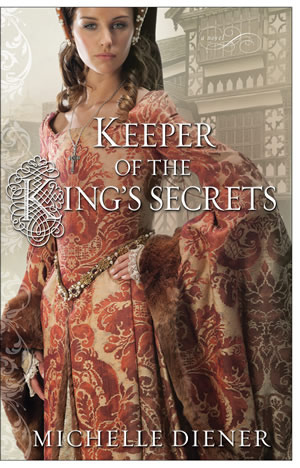 A priceless jewel.A royal court rife with intrigue.A secret deal, where the price of truth could come too high.
A priceless jewel.A royal court rife with intrigue.A secret deal, where the price of truth could come too high.
The personal artist to King Henry Tudor, Susanna Horenbout is sought by the queen and ladies of the court for her delicate, skilled portraits. But now someone from her past is pulling her into a duplicitous game where the consequence of failure is war. Soon, Susanna and her betrothed, the King's most dangerous courtier, are unraveling a plot that would shatter Europe. And at the heart of it is a magnificent missing diamond.
With John Parker at her side, Susanna searches for the diamond and those responsible for its theft, their every step dogged by a lethal assassin. Finding the truth means plunging into the heart of the court's most bitter infighting, surviving the harrowing labyrinth of Fleet Prison—and then coming face-to-face with the most dangerous enemy of all.
Keeper of the King's Secrets is the sequel to In a Treacherous Court and continues the story of Susanna Horenbout and John Parker.
Once again, author Michelle Diener strikes a balance between intrigue, mystery, romance, and believable, well-developed characters. The secrets surrounding the Mirror of Naples captivated me and kept me reading. This book is definitely a bit of a page-turner aided along by an endearing love affair between the hero and heroine.
In a book market that is far too oversaturated with Tudor novels, don't let this book scare you away. The characters in this story are lesser-known historical figures and fictional characters who reside on the peripheral of the Tudor court. Although there is much mention of the historical complexities of the time, the story is entertaining. Otherwise, I do not think I could have tolerated reading yet another novel about the far too over-done Tudors.
Although there is a romantic element in this novel, it does not resemble a formula romance. Rather, it is more of an adventure and mystery story with an element of unpredictability. And this is precisely why Michelle Diener's novels are so much fun!
I LOVE COMMENTS










Published on March 17, 2012 14:07
March 16, 2012
Hoyden of the Week - A gypsy's curse to hell!
Published on March 16, 2012 19:13
March 15, 2012
The King's Agent by Donna Russo Morin
Historical Fiction fantasy with the thrill of adventure!
[image error]
Welcome to all the guests of the blog tour for The King's Agent!
Also visit Historical Novel Review
The tour scheduleTour schedule: http://hfvirtualbooktours.blogspot.com/2011/11/donna-russo-morin-on-tour-for-kings.html [image error]
Links for author Donna Russo Morin: WEBSITE | FACEBOOK | TWITTER
Twitter Event Hashtag: #KingsAgentVirtualBookTour
Book Description
An adventurous quest in Renaissance Italy with undercurrents of the supernatural, powers that could change the balance of supremacy throughout Europe.
To the casual observer, Battista della Paglia is an avid art collector, or perhaps a nimble thief. In reality, the cunning Italian is an agent for François, the King of France, for whom he procures the greatest masterpieces of the day by any means necessary. Embroiled in a power struggle with Charles V, the King of Spain, François resolves to rule Europe's burgeoning cultural world. When he sets his sights on a mysterious sculpture, Battista's search for the elusive objet d'art leads him to a captivating woman on a mission of her own. . .
Having spent her life under the controlling eye of her protector, the Marquess of Mantua, Aurelia longs for freedom. And she finds it in Battista. Together, they embark on a journey to find the clues that will lead him to the sculpture-- a venture so perilous it might have spilled from the pen of Dante himself. From the smoldering depths of Rome to a castle in the sky, the harrowing quest draws them inextricably together. But Aurelia guards a dark secret that could tear them apart--and change the course of history. . .
THE KING'S AGENT is based on the real life of Battista della Palla—a patriotic plunderer, a religious rogue—of the 16th century, a lifelong friend to the great Michelangelo. To some he is an avid art collector, or perhaps a nimble thief. In reality, the cunning Italian is an agent for François, the King of France, for whom he procures the greatest masterpieces of the day by any means necessary. When François sets his sights on a mysterious sculpture, Battista's search for the elusive object leads him to a woman with a mission of her own.
As the cloistered ward of the Marquess of Mantua, the Lady Aurelia is a woman with a profound duty, and a longing for adventure. In search of the relic, Battista and Aurelia cross the breathtaking landscape of Renaissance Italy. Clues hide in great works of art—symbols that speak of other worldly forces—political forces collide, secret societies and enemies abound, and danger lurks in every challenge, those that mirror the passages of Dante's Divine Comedy.
Book Review
The King's Agent by Donna Russo Morin is a fun historical fantasy adventure set in Renaissance Italy. At the heart of the story is Battista della Palla, a true historical figure, who is an art aficionado/procurer who is searching for a sculpture that will convince the King of France to lend his support to defend Florence. While committing an art theft, Lady Aurelia comes to his rescue and convinces him to take her with him in his adventures. As they work to unlock the mystery based upon Dante's Divine Comedy, they trek perilously in dark corridors beneath dark castles, muddle through labyrinths, find openings to secret doors, and discover mysterious clues that lead to dark secrets.
Michelangelo is a minor character and his relationship with Aurelia is quite endearing as the story unfolds. The pages of this novel are filled with brilliant descriptions and dazzling details, typical of Donna Russo Morin's style. This novel is a remarkably intricate and captivating romance sprinkled with intrigue, adventure, gothic style labyrinths, history, art, mystery, and much more. Rich and complex, there is something here for every reader. As inspiration for this work, the author reveals her passion for the video game Zelda, which helped her build a strong foundation with her this sons as they were growing up. I also enjoyed following Dante's Inferno as the mystery of the story was revealed.
This was a novel to savour and enjoy the richness that leaps off every page as you read it. Highly recommended.
AUTHOR BIO

Donna Russo Morin was born in Providence, Rhode Island in 1958. Her writing endeavors began at age six and covered such timely topics as The Pink Pussy Cat for President and The Numbers 2 and 4 are in Love.
Traveling through adolescence on the wings of the '60s gave Donna a lot of grist for her writing mill. Feminism, civil rights, the Vietnam War were all a disturbing yet highly motivating muse. Donna found her voice in fiction and with the appearance of a new horror writer on the book scene, a little known author named Stephen King, she turned her pen to the gruesome and the grotesque.
After graduating from the University of Rhode Island, Donna worked in marketing and advertising for large corporations and small non-profit arts organizations. When she had her children, she knew with a certainty that she needed to show them, by example, that if you believe in yourself, anything is possible.
In addition to writing and teaching writing, Donna has worked as a model and actor since the age of seventeen, when she did her first television commercial for Sears. Since then she has appeared in more than thirty television spots and print ads, everything from changing the oil in her car (that was acting) to modeling fur coats. She also appeared in three episodes of Showtime's THE BROTHERHOOD, as well as in Martin Scorsese's THE DEPARTED.
Donna lives peacefully, close to the beautiful shoreline of Rhode Island that she loves so much, with her two sons, Devon and Dylan, her greatest works in progress.
I LOVE COMMENTS










[image error]
Welcome to all the guests of the blog tour for The King's Agent!
Also visit Historical Novel Review
The tour scheduleTour schedule: http://hfvirtualbooktours.blogspot.com/2011/11/donna-russo-morin-on-tour-for-kings.html [image error]
Links for author Donna Russo Morin: WEBSITE | FACEBOOK | TWITTER
Twitter Event Hashtag: #KingsAgentVirtualBookTour
Book Description
An adventurous quest in Renaissance Italy with undercurrents of the supernatural, powers that could change the balance of supremacy throughout Europe.
To the casual observer, Battista della Paglia is an avid art collector, or perhaps a nimble thief. In reality, the cunning Italian is an agent for François, the King of France, for whom he procures the greatest masterpieces of the day by any means necessary. Embroiled in a power struggle with Charles V, the King of Spain, François resolves to rule Europe's burgeoning cultural world. When he sets his sights on a mysterious sculpture, Battista's search for the elusive objet d'art leads him to a captivating woman on a mission of her own. . .
Having spent her life under the controlling eye of her protector, the Marquess of Mantua, Aurelia longs for freedom. And she finds it in Battista. Together, they embark on a journey to find the clues that will lead him to the sculpture-- a venture so perilous it might have spilled from the pen of Dante himself. From the smoldering depths of Rome to a castle in the sky, the harrowing quest draws them inextricably together. But Aurelia guards a dark secret that could tear them apart--and change the course of history. . .
THE KING'S AGENT is based on the real life of Battista della Palla—a patriotic plunderer, a religious rogue—of the 16th century, a lifelong friend to the great Michelangelo. To some he is an avid art collector, or perhaps a nimble thief. In reality, the cunning Italian is an agent for François, the King of France, for whom he procures the greatest masterpieces of the day by any means necessary. When François sets his sights on a mysterious sculpture, Battista's search for the elusive object leads him to a woman with a mission of her own.
As the cloistered ward of the Marquess of Mantua, the Lady Aurelia is a woman with a profound duty, and a longing for adventure. In search of the relic, Battista and Aurelia cross the breathtaking landscape of Renaissance Italy. Clues hide in great works of art—symbols that speak of other worldly forces—political forces collide, secret societies and enemies abound, and danger lurks in every challenge, those that mirror the passages of Dante's Divine Comedy.
Book Review
The King's Agent by Donna Russo Morin is a fun historical fantasy adventure set in Renaissance Italy. At the heart of the story is Battista della Palla, a true historical figure, who is an art aficionado/procurer who is searching for a sculpture that will convince the King of France to lend his support to defend Florence. While committing an art theft, Lady Aurelia comes to his rescue and convinces him to take her with him in his adventures. As they work to unlock the mystery based upon Dante's Divine Comedy, they trek perilously in dark corridors beneath dark castles, muddle through labyrinths, find openings to secret doors, and discover mysterious clues that lead to dark secrets.
Michelangelo is a minor character and his relationship with Aurelia is quite endearing as the story unfolds. The pages of this novel are filled with brilliant descriptions and dazzling details, typical of Donna Russo Morin's style. This novel is a remarkably intricate and captivating romance sprinkled with intrigue, adventure, gothic style labyrinths, history, art, mystery, and much more. Rich and complex, there is something here for every reader. As inspiration for this work, the author reveals her passion for the video game Zelda, which helped her build a strong foundation with her this sons as they were growing up. I also enjoyed following Dante's Inferno as the mystery of the story was revealed.
This was a novel to savour and enjoy the richness that leaps off every page as you read it. Highly recommended.
AUTHOR BIO

Donna Russo Morin was born in Providence, Rhode Island in 1958. Her writing endeavors began at age six and covered such timely topics as The Pink Pussy Cat for President and The Numbers 2 and 4 are in Love.
Traveling through adolescence on the wings of the '60s gave Donna a lot of grist for her writing mill. Feminism, civil rights, the Vietnam War were all a disturbing yet highly motivating muse. Donna found her voice in fiction and with the appearance of a new horror writer on the book scene, a little known author named Stephen King, she turned her pen to the gruesome and the grotesque.
After graduating from the University of Rhode Island, Donna worked in marketing and advertising for large corporations and small non-profit arts organizations. When she had her children, she knew with a certainty that she needed to show them, by example, that if you believe in yourself, anything is possible.
In addition to writing and teaching writing, Donna has worked as a model and actor since the age of seventeen, when she did her first television commercial for Sears. Since then she has appeared in more than thirty television spots and print ads, everything from changing the oil in her car (that was acting) to modeling fur coats. She also appeared in three episodes of Showtime's THE BROTHERHOOD, as well as in Martin Scorsese's THE DEPARTED.
Donna lives peacefully, close to the beautiful shoreline of Rhode Island that she loves so much, with her two sons, Devon and Dylan, her greatest works in progress.
I LOVE COMMENTS










Published on March 15, 2012 04:13
March 10, 2012
Beautiful Eyes - A breathtaking collection
Inspirational and breathtaking! Eyes truly are the window to the soul!
Most authors work hard to describe protagonists and antagonists. Often, eyes are a very important part of that description. It helps breathe life into our characters, helping them become real to readers. In my research I stumbled upon this video and the beautiful eyes within are absolutely breathtaking.
I LOVE COMMENTS










Most authors work hard to describe protagonists and antagonists. Often, eyes are a very important part of that description. It helps breathe life into our characters, helping them become real to readers. In my research I stumbled upon this video and the beautiful eyes within are absolutely breathtaking.
I LOVE COMMENTS










Published on March 10, 2012 17:38
March 9, 2012
Hoyden of the Week - Smoke if you're 100!

I couldn't resist posting this picture of a lovely hoyden at the ripe old age of 100. If I ever reach that age, hell, I'd have a good time too! Be naughty Grandma! It sure feels good, don't it! I LOVE COMMENTS










Published on March 09, 2012 17:07
The Midwife of Venice by Roberta Rich

Synopsis
At midnight, the dogs, cats, and rats rule Venice. The Ponte di Ghetto Nuovo, the bridge that leads to the ghetto, trembles under the weight of sacks of rotting vegetables, rancid fat, and vermin. Shapeless matter, perhaps animal, floats to the surface of Rio di San Girolamo and hovers on its greasy waters. Through the mist rising from the canal the cries and grunts of foraging pigs echo. Seeping refuse on the streets renders the pavement slick and the walking treacherous.
It was on such a night that the men came for Hannah.
Hannah Levi is known throughout sixteenth-century Venice for her skill in midwifery. When a Christian count appears at Hannah's door in the Jewish ghetto imploring her to attend his labouring wife, who is nearing death, Hannah is forced to make a dangerous decision. Not only is it illegal for Jews to render medical treatment to Christians, it's also punishable by torture and death. Moreover, as her Rabbi angrily points out, if the mother or child should die, the entire ghetto population will be in peril.
But Hannah's compassion for another woman's misery overrides her concern for self-preservation. The Rabbi once forced her to withhold care from her shunned sister, Jessica, with terrible consequences. Hannah cannot turn away from a labouring woman again. Moreover, she cannot turn down the enormous fee offered by the Conte. Despite the Rabbi's protests, she knows that this money can release her husband, Isaac, a merchant who was recently taken captive on Malta as a slave. There is nothing Hannah wants more than to see the handsome face of the loving man who married her despite her lack of dowry, and who continues to love her despite her barrenness. She must save Isaac.
Meanwhile, far away in Malta, Isaac is worried about Hannah's safety, having heard tales of the terrifying plague ravaging Venice. But his own life is in terrible danger. He is auctioned as a slave to the head of the local convent, Sister Assunta, who is bent on converting him to Christianity. When he won't give up his faith, he's traded to the brutish lout Joseph, who is renowned for working his slaves to death. Isaac soon learns that Joseph is heartsick over a local beauty who won't give him the time of day. Isaac uses his gifts of literacy and a poetic imagination—not to mention long-pent-up desire—to earn his day-to-day survival by penning love letters on behalf of his captor and a paying illiterate public.
Back in Venice, Hannah packs her ""birthing spoons"—secret rudimentary forceps she invented to help with difficult births—and sets off with the Conte and his treacherous brother. Can she save the mother? Can she save the baby, on whose tiny shoulders the Conte's legacy rests? And can she also save herself, and Isaac, and their own hopes for a future, without endangering the lives of everyone in the ghetto?
The Midwife of Venice is a gripping historical page-turner, enthralling readers with its suspenseful action and vivid depiction of life in sixteenth-century Venice. Roberta Rich has created a wonderful heroine in Hannah Levi, a lioness who will fight for the survival of the man she loves, and the women and babies she is duty-bound to protect, carrying with her the best of humanity's compassion and courage.
Review
The Midwife of Venice is one of the best novels I've read. It is no wonder it became an International Bestseller. The novel is beautifully written; its simplicity makes it delightful to read and allows the reader to immerse themselves completely into the story seamlessly.
There are numerous novels written with Venice as a backdrop, but author Roberta Rich sweeps us into a lesser known and darker side of the city's majestic history – the plight of the Jews who lived there. In a city that was famous for its port and used to exotic people and trade, it caught me by surprise how racist and prejudiced the people were against the Jews at the time.
Not only did the author do a great deal of research into Venice and its historical details, she also delved into the ancient skills and beliefs of midwifery. Kidnapping, murder, superstition, birthing spoons, and the plague grace the pages of this exciting new novel. The heroine is likeable and believable, but more importantly, fascinating. There are tragic scenes along with joyous ones as the story takes you from one event to another. There is never a moment of boredom. The pace is quick, the story unencumbered with too much narrative or description.
For me, this book is a definite keeper and now sits on my shelf along with my other most cherished books. I highly recommend it, for it is sure to please!
I LOVE COMMENTS










Published on March 09, 2012 10:26
February 28, 2012
An Italian Medieval Cassone
Cassone - a beautiful bridal in the Middle Ages and Renaissance!
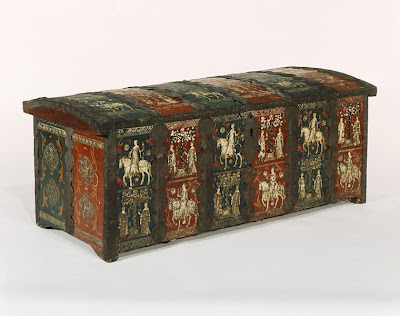 Cassone from Florence or Siena in the 14th CenturyMade from poplar, this cassone is covered with canvas.It is painted red and blue and decorated with tin leaf and gesso figures.Iron bands reinforce its sturdiness.
Cassone from Florence or Siena in the 14th CenturyMade from poplar, this cassone is covered with canvas.It is painted red and blue and decorated with tin leaf and gesso figures.Iron bands reinforce its sturdiness.
Today, I was researching 13th century Italian weddings and I came across the tradition of providing the bride with a cassone.
Italian Florentine CassoneA cassone is a medieval or renaissance marriage chest given to the bride by her parents on her wedding day. These chests were so important, they were often adorned, gilded, carved, or decorated illustriously images of the bride, the family, or some other important event pertaining to them. After the wedding, these beautiful, ornate trunks were usually moved to the bridal chamber and became a special place for the bride to store all her most personal belongings or treasures. The practice is still somewhat in use today, with parents filling the trunk with precious linens and keepsakes.
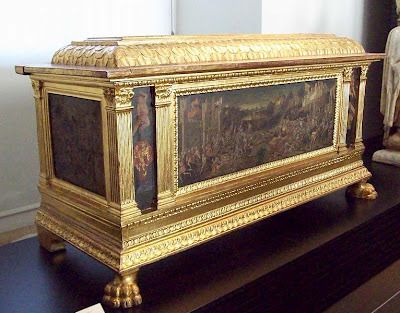
This chest was also made in Florence and depicts a famous battle. It is made of cedar and is decorated with gold leaf and oil on wood paintings
Not only were the cassoni beautiful to look at, they were practical for storage or even could be used as furniture. Because cassoni were often so large and heavy, it could be used as a table or a place upon which to sit when set against a wall. More often than not, however, they were usually found at the foot of a bed.
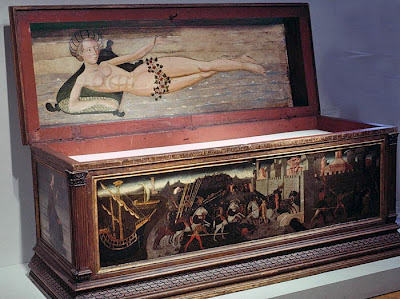
15th Century CassoneBirth of Venus
How beautiful. When I win the lottery, I'll definitely become an avid collector. What a treasure for a new bride to take with her into her new life.
I LOVE COMMENTS










 Cassone from Florence or Siena in the 14th CenturyMade from poplar, this cassone is covered with canvas.It is painted red and blue and decorated with tin leaf and gesso figures.Iron bands reinforce its sturdiness.
Cassone from Florence or Siena in the 14th CenturyMade from poplar, this cassone is covered with canvas.It is painted red and blue and decorated with tin leaf and gesso figures.Iron bands reinforce its sturdiness.Today, I was researching 13th century Italian weddings and I came across the tradition of providing the bride with a cassone.
Italian Florentine CassoneA cassone is a medieval or renaissance marriage chest given to the bride by her parents on her wedding day. These chests were so important, they were often adorned, gilded, carved, or decorated illustriously images of the bride, the family, or some other important event pertaining to them. After the wedding, these beautiful, ornate trunks were usually moved to the bridal chamber and became a special place for the bride to store all her most personal belongings or treasures. The practice is still somewhat in use today, with parents filling the trunk with precious linens and keepsakes.

This chest was also made in Florence and depicts a famous battle. It is made of cedar and is decorated with gold leaf and oil on wood paintings
Not only were the cassoni beautiful to look at, they were practical for storage or even could be used as furniture. Because cassoni were often so large and heavy, it could be used as a table or a place upon which to sit when set against a wall. More often than not, however, they were usually found at the foot of a bed.

15th Century CassoneBirth of Venus
How beautiful. When I win the lottery, I'll definitely become an avid collector. What a treasure for a new bride to take with her into her new life.
I LOVE COMMENTS










Published on February 28, 2012 17:39
February 27, 2012
The Needle in the Blood by Sarah Bower
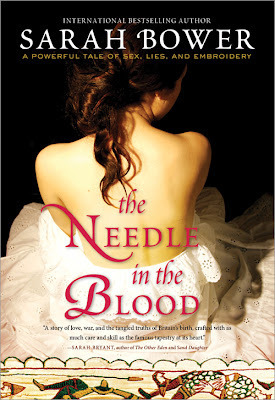 January 1067. Charismatic Bishop Odo of Bayeux decides to commission a wall hanging, on a scale never seen before, to celebrate his role in the conquest of Britain by his brother, William, Duke of Normandy. What he cannot anticipate is how utterly this will change his life – even more than the invasion itself. His life becomes entangled with the women who embroider his hanging, especially Gytha – handmaiden to the fallen Saxon queen and his sworn enemy. But against their intensions they fall helplessly in love; in doing so Odo comes into conflict with his king and his God and Gytha with Odo's enemies, who mistrust her hold over such a powerful man. Friends and family become enemies, enemies become lovers; nothing in life or in the hanging is what it seems. The Needle in the Blood – a powerful tale of sex, lies and embroidery.
January 1067. Charismatic Bishop Odo of Bayeux decides to commission a wall hanging, on a scale never seen before, to celebrate his role in the conquest of Britain by his brother, William, Duke of Normandy. What he cannot anticipate is how utterly this will change his life – even more than the invasion itself. His life becomes entangled with the women who embroider his hanging, especially Gytha – handmaiden to the fallen Saxon queen and his sworn enemy. But against their intensions they fall helplessly in love; in doing so Odo comes into conflict with his king and his God and Gytha with Odo's enemies, who mistrust her hold over such a powerful man. Friends and family become enemies, enemies become lovers; nothing in life or in the hanging is what it seems. The Needle in the Blood – a powerful tale of sex, lies and embroidery.The Needle in the Blood by Sarah Bower is a novel that takes place in the 11th century England. It is about the making of the Bayeux Tapestry, a colourful, embroidered linen cloth, 230 feet long, which depicts fifty historical scenes from before the Norman conquest of England to the Battle of Hastings. The cloth is believed to have been commissioned by Bishop Odo.
At the heart of the story is a woman named Gytha, a serving maid to King Harold's consort, the Lady Edith. When King Harold is killed during the Battle of Hastings, Bishop Odo of Bayeux, brother of William the Conquerer, refuses to allow the king's body to be returned to his family for burial. Later, Gytha manages to hide and avoids being captured and sent away with Lady Edith and her other ladies. Left destitute, with no means of support, Gytha falls upon a time of great suffering. Her one hope is that she can soon find work as an embroideress, putting to use her exceptional talent.
At first, her bitterness and hatred of Odo, resides rampant within her. She is determined to kill him. A stroke of fortune brings her directly into his path when she is recruited by his sister, a nun of dubious repute, to help sew the Bayeux Tapestry.
The Needle in the Blood is an historical novel about forbidden love, the treachery of war, and healing. It is a profound piece of work, rich with complexity and detail of this fascinating period. Sarah Bower gives us a rare insight into the complexities of a bloody and violent period in England's history.
Along with a gradually enfolding romance, the author does not hesitate to show readers the harsh brutalities and ferocious carnage that was prevalent, and the helplessness of women to exert even the most basic control over their own lives.
The writing is deep and alluring, and a bit challenging. It is pure historical fiction with plenty of historical data weaved into the plot. Overall, it is an epic tale and one well worth reading! Highly recommended!The book will be released on March 1st, 2012. Here are the links to pre-order:
I LOVE COMMENTS










Published on February 27, 2012 15:51
Makeda by Prue Sobers
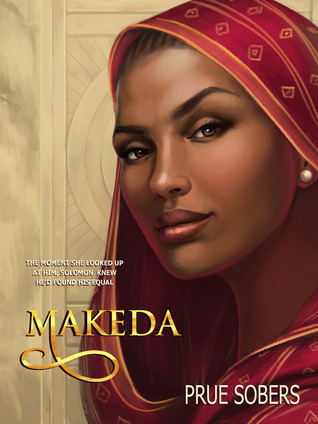 A novel inspired by a medieval text and its ancient tale of sexual conquest by Australian best-selling author, Prue Sobers.
A novel inspired by a medieval text and its ancient tale of sexual conquest by Australian best-selling author, Prue Sobers.
A woman stands in a hooded cloak, feet drenched and muddied, at the entrance of the great hall as thunder reverberates through the palace walls. In the gloom he cannot see her clearly. It is before the Common Era, the year 961. He is Solomon the Wise, thwarted by protocol, impatient for his work. She is the beautiful and spirited Makeda, Queen of Sheba and all Ethiopia who has risked life and limb in a bid to talk trade. Against a glittering backdrop of pomp and opulence, and the shadows of slavery and the politics of the times, as strangers, they embark on an uncharted course.
She is not what he expects and takes him by surprise. He is everything she has heard. Behind the closed doors of privilege and power, both are about to face more than they bargain for.
Brimming with imagery, taut with intrigue, Makeda is a light with incident and glamour. In her compelling novel of obsession and self-discovery, Prue Sobers brings to life two of the world's most illustrious icons, rendering them enthralling in all their dazzling otherness, yet as human and palpable as legends of our day. Feisty and engaging, the novel takes the reader into the minds of its characters, foiling all the energy of sovereignty and might with the exquisite eroticism of attraction and desire. Emotionally rich and evocative, this bitter-sweet story of moral dilemma, grand passions and sacrifice will tug whimsically on the strings long after it is read.
From its beautiful front cover and lovely prose within its pages, the novel Makeda definitely drew me in and swept me back into ancient history. It is the heated love story between King Solomon and Makeda, Queen of Sheba, both powerful, wealthy leaders in their own lands.
Within its pages, author, Prue Sobers, deftly tackles powerful subjects such as slavery and oppression by weaving Makeda's life story and detailing the splendid romance that unfolds between her and Solomon. The author writes with great skill, gentle clarity, and avid enough descriptions to truly give readers a strong sense of the era.
I enjoyed Makeda's talent to verbally spar with Solomon, impressing instead of offending, fascinating instead of angering. She was a woman of great resilience, courageous enough to speak her mind and unafraid to act on her moral ethics. Makeda is a true heroine, one who has transcends time, whereby her dignity and brilliance fascinates to this day. A wonderful biographical historical novel!
I LOVE COMMENTS










Published on February 27, 2012 13:45








